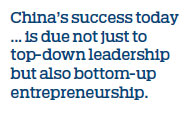Amazing changes of China seen far and wide
Even after 30 years in China, my wife and I still stroll daily around Xiamen, Fujian province, as if we were tourists enjoying it for the first time. No wonder our beautiful island city won the international award for livable communities in 2002, and a UNESCO habitat award in 2004.
But Xiamen today is worlds apart from what we encountered when our family stepped off the boat in an 18-hour journey from Hong Kong to arrive there in 1988.

Even into the 1990s, we had water and power outages almost daily. Stores had little to sell. Roads were narrow and potholed, and buses were so few that I bought a pedicab for my family. I'd ridden my new pedicab only 200 meters when a man yelled at me, "How much to Zhongshan Park?"
Although reform and opening-up began in 1978, change was still relatively slow as people argued about how to change, and how fast. But in 1992, the country's leader, Deng Xiaoping, galvanized the local authorities and common folk alike when he visited South China and, with Chinese pragmatism, told people, "It does not matter if a cat is black or white. If it catches mice, it's a good cat."

When I started writing articles about China's rapid growth, some foreigners criticized me. "You've only seen the coast, not the hinterlands." So I bought a van to help me explore the country.
In 1994, I drove my wife and two sons for more than 40,000 kilometers around China - from Xiamen up the coast to Beijing and the Inner Mongolia autonomous region, through the Gobi Desert to the Tibet autonomous region, and back through South China.
Even in remote areas such as the Ningxia Hui autonomous region and Gansu province, the central government was building new roads, schools and hospitals. I wondered what could possibly justify the expense when the people were so poor, but modern leaders, like their ancient predecessors, set very long-term goals. Chinese say, "Give a fish and feed for one day; teach to fish and feed for a lifetime." Beijing knew that doling out welfare would not end poverty, so authorities built an infrastructure such that even remote farmers could lift themselves from poverty - and this strategy bore fruit!
On June 24, 2017, the World Economic Forum noted that China had accounted for over three-quarters of global poverty reduction between 1990 and 2005.
Even ancient Chinese leaders met the needs of China's large population, with massive engineering projects such as the Grand Canal stretching nearly 2,000 km and the Dujiangyan water project, which for more than 2,200 years has irrigated 5,500 sq km, making Sichuan province an agricultural center. Like their predecessors, modern leaders have also engaged in breathtaking engineering projects. We no longer have water and power outages, thanks to feats such as the South-to-North Water Diversion project and the Three Gorges Dam. A major national highway project also cut one of my drives from 35 hours in 1993 to seven hours today, though I seldom use the car because we also have the world's best high-speed train network.
China's success today, as in the past, is due not just to top-down leadership but also bottom-up entrepreneurship - such as Yang Ying, a Fujian farm girl with four years' education. In 1981, she dreamed of making 20 yuan ($2.95) a month as a Xiamen University professor's maid. Today, she is a multimillionaire dabbling in international schools, real estate holdings and a biotech company.
Yang supports every retiree in her hometown and is building 1,000 Project Hope schools. I know others, such as a tea farmer who 30 years ago brewed weeds because he was too poor to drink his own tea but today owns a fine home and car. There is also a street sweeper who is proud that his life, though simple, has improved greatly - including his son who is attending a top university.
China's amazing changes remind me of Eustace Budgell, an English writer and politician who in 1731 wrote that everyone knew of China's "four great inventions", but "what Chinese are universally allowed, even at this day, to excel all other nations in, is, the art of government".
Chinese people's dreams are being realized today, thanks to visionary leadership and capable citizenry. Most important to me is that China has steadfastly pursued peaceful economic development. With such a heritage, I can agree with President Xi Jinping, who said during Spring Festival that China's future will be even better.
The author is academic director of the SMXMU OneMBA program at Xiamen University in Fujian province. The views do not necessarily reflect those of China Daily.
(China Daily 02/12/2019 page1)


















